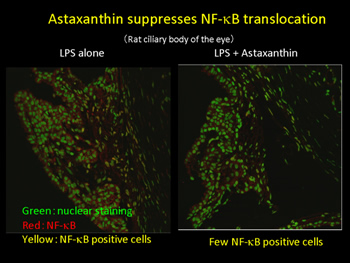Astaxanthin, naturally occurring pigment, helps reduce eye strain

Astaxanthin suppressed NF-kB translocation in endotoxin-induced uveitis in rats
A research group led by Associate Prof. Nobuyoshi Kitaichi (Department of Ophthalmology, Health Sciences University of Hokkaido, and visiting associate professor to the HU Graduate School of Medicine) revealed that Astaxanthin, a naturally occurring carotenoid, is effective in relieving the symptoms of inflammatory eye diseases and eye strain (asthenopia).
Astaxanthin is red colors found in foods such as salmon, salmon roe, shrimp, and crab shells. Associate Prof. Kitaichi and his colleagues administered it to lab rats with inflammatory eye diseases and noted a marked reduction of inflammation. The research group also gave dietary supplements containing Astaxanthin to adult volunteers with asthenopia over a period of four weeks. Those taking the supplements experienced an improvement in their condition compared to those in the control group. A corollary between administration period and effect was noted; the longer periods of administration, the better eye condition.
Associate Prof. Kitaichi envisions that these research results will be beneficial not only to promote human health, but will also contribute to local industries by using locally abundant salmon and salmon roe.
Contact information:
Associate Prof. Nobuyoshi Kitaichi
E-mail: nobukita@hoku-iryo-u.ac.jp
